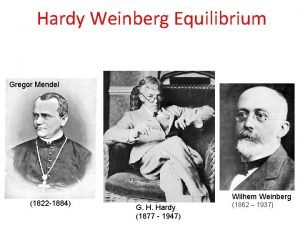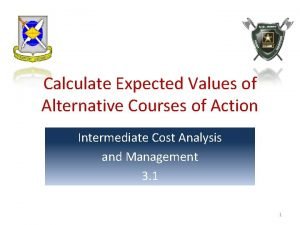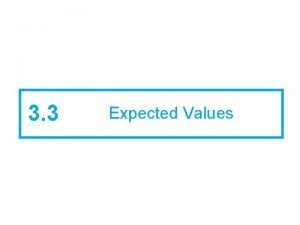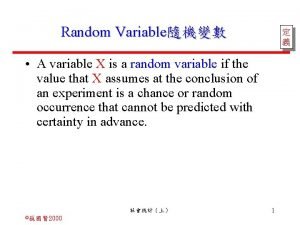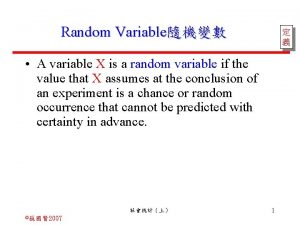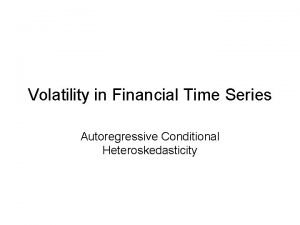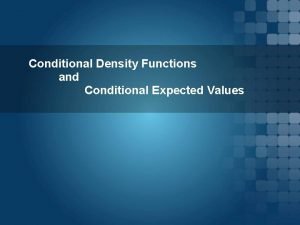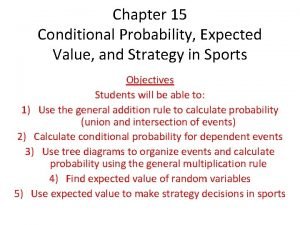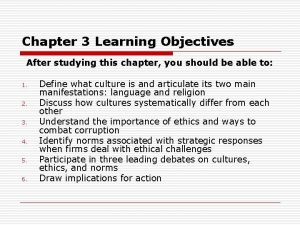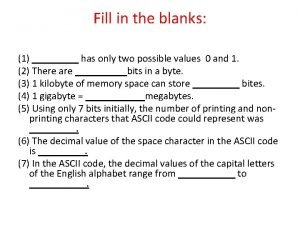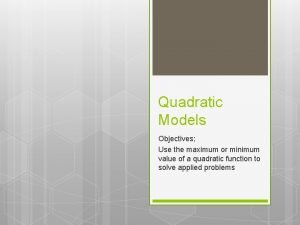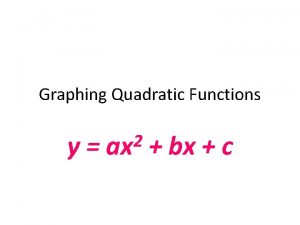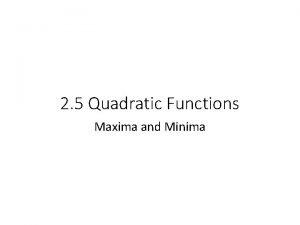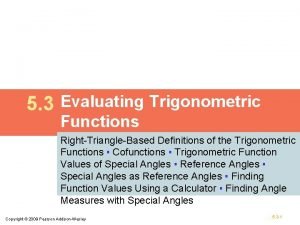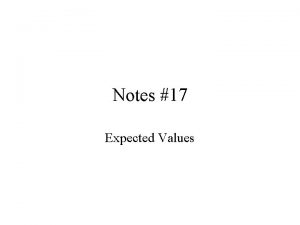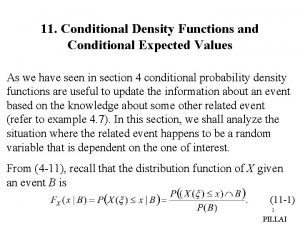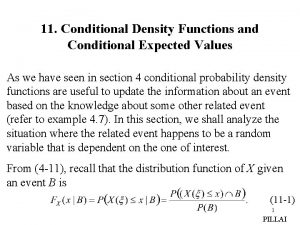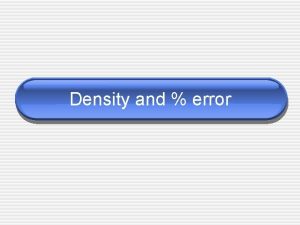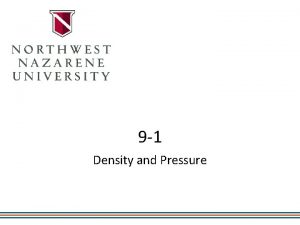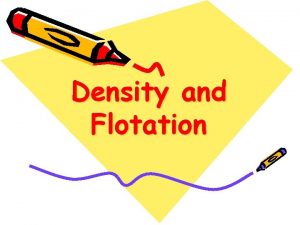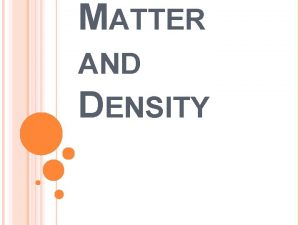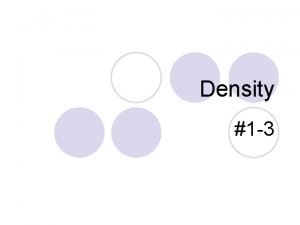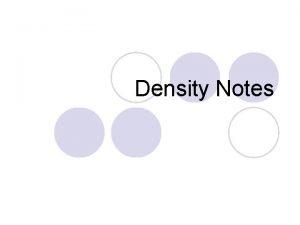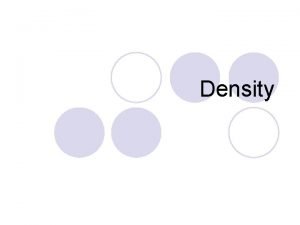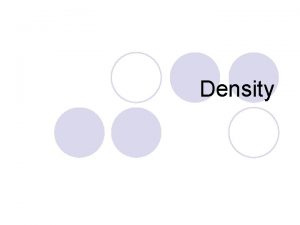Conditional Density Functions and Conditional Expected Values Conditional






















- Slides: 22

Conditional Density Functions and Conditional Expected Values

§ Conditional probability density functions: useful to update the information about an event based on the knowledge about some other related event § We shall analyze the situation where the related event happens to be a random variable that is dependent on the one of interest. § Recall that the distribution function of X given an event B is

§ Suppose, we let § Then § This can be rewritten as

§ To determine, the limiting case let and § This gives § and hence in the limit § Thus § and The subscript X | Y is used to remind about the conditional nature

§ We have § and § Thus the formula represents a valid p. d. f. § We shall refer to it as the conditional p. d. f of the r. v X given Y = y. We may also write § Thus we have and similarly

§ If the r. vs X and Y are independent, then previous formuls reduces to and the § This makes sense, since if X and Y are independent r. vs, information about Y shouldn’t be of any help in updating our knowledge about X. § In the case of discrete-type r. vs, § How to obtain conditional p. d. fs? reduces to

Example § Given § determine Solution § Similarly § and

Example - continued § Also, § and § From § or § But , we also have

Example - continued § So, § This represents the p. d. f version of Bayes’ theorem. § This is very significant in communication problems § In these problems, observations can be used to update our knowledge about unknown parameters.

Example § An unknown random phase is uniformly distributed in § where n § Determine Solution § Initially almost nothing about the r. v is known. § We assume its a-priori p. d. f to be uniform in the interval § In we can think of - n as the noise contribution - r as the observation. § It is reasonable to assume that and n are independent.

Example - continued § In that case Since it is given that is a constant, § This gives the a-posteriori p. d. f of given r : where behaves like n.

Example - continued The knowledge about the observation r is reflected in the a-posteriori p. d. f of . It is no longer flat as the a-priori p. d. f It shows higher probabilities in the neighborhood of (a) a-priori p. d. f of (b) a-posteriori p. d. f of

Conditional Mean § Defined using conditional p. d. fs § using a limiting argument, § This is the conditional mean of X given Y = y. § Note that will be a function of y. Also

Conditional Variance § In a similar manner, the conditional variance of X given Y = y is given by

Example § Let § Determine and Solution § § So in the shaded area, and zero elsewhere.

Example - continued § Hence § As generalization of the conditional mean formulas,

Example - continued § Also, § Here the inner expectation is with respect to X and the outer expectation is with respect to Y.

Example - continued § Letting g( X ) = X in this equation we get where the inner expectation on the right side is with respect to outer one is with respect to Y. § Similarly, we have § We can also obtain X and the

Estimation with Conditional Mean § Conditional mean turns out to be an important concept in estimation and prediction theory. § What is the best predicted value of Y given that X = x ? § It turns out that - if “best” is meant in the sense of minimizing the mean square error between Y and its estimate , then - the conditional mean of Y given X = x, i. e. , is the best estimate for.

Example: Poisson Sum of Bernoulli Random Variables § Let represent independent, identically distributed Bernoulli random variables with § and N a Poisson random variable with parameter all. that is independent of § Consider the random variables § Show that Y and Z are independent Poisson random variables.

Solution § To determine the joint probability mass function of Y and Z, consider

Solution - continued § Thus and Y and Z are independent random variables. § Thus - if a bird lays eggs that follow a Poisson random variable with parameter , - and if each egg surviveswith probability p, § then the number of chicks that survive also forms a Poisson random variable with parameter
 35 +0 2+1per10
35 +0 2+1per10 Alternative courses of action definition
Alternative courses of action definition Expected value
Expected value Variance of the random variable
Variance of the random variable Variance of the random variable
Variance of the random variable Explain the specific gravity
Explain the specific gravity Linear density of fcc (111)
Linear density of fcc (111) Linear density of fcc 110
Linear density of fcc 110 Physiological density vs arithmetic density
Physiological density vs arithmetic density Nda full dac
Nda full dac Arithmetic density
Arithmetic density Conditional expected value
Conditional expected value Conditional variance
Conditional variance Conditional expected value
Conditional expected value Machiavellian personality
Machiavellian personality Terminal values and instrumental values
Terminal values and instrumental values Western values vs eastern values
Western values vs eastern values A bit can have two possible values what value are those
A bit can have two possible values what value are those Classification of human values
Classification of human values Maximum and minimum values of quadratic functions
Maximum and minimum values of quadratic functions Maximum and minimum values of quadratic functions
Maximum and minimum values of quadratic functions Maxima minima of quadratic equation
Maxima minima of quadratic equation Reference angle example
Reference angle example
